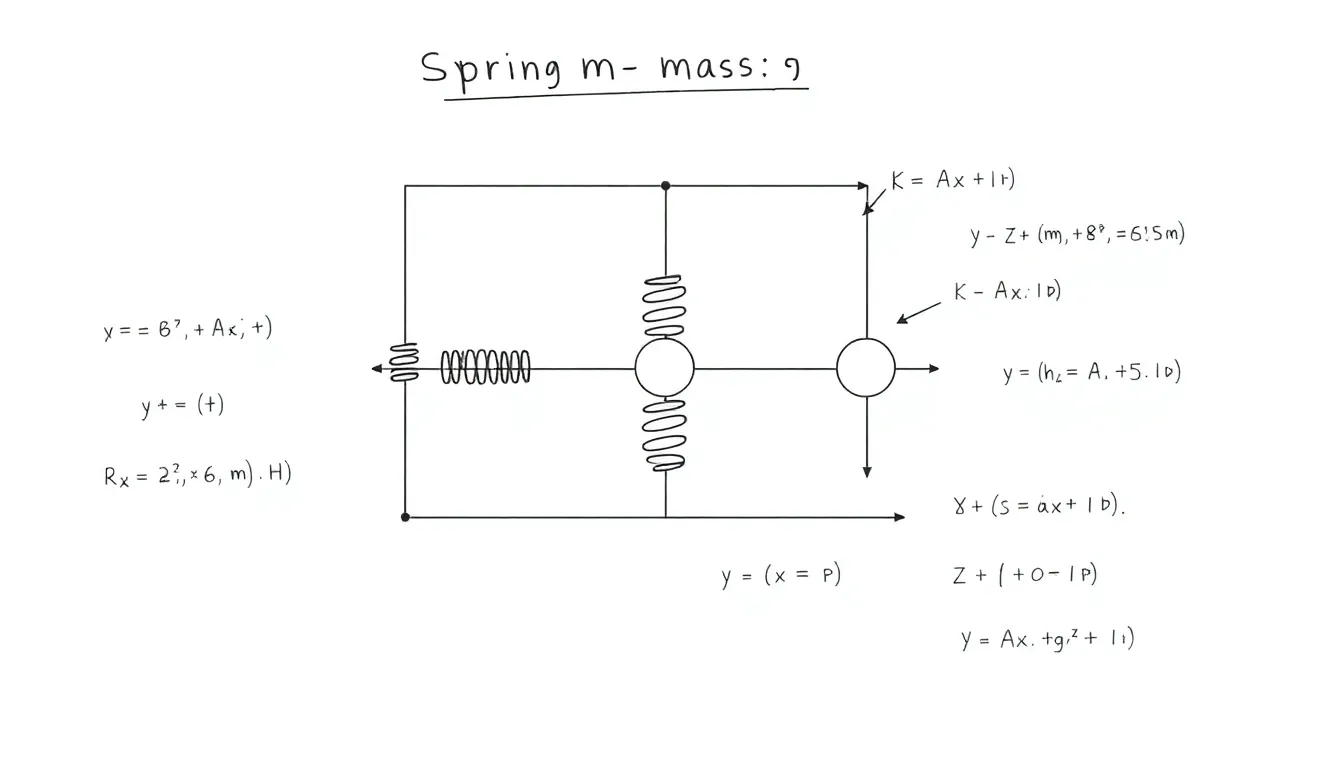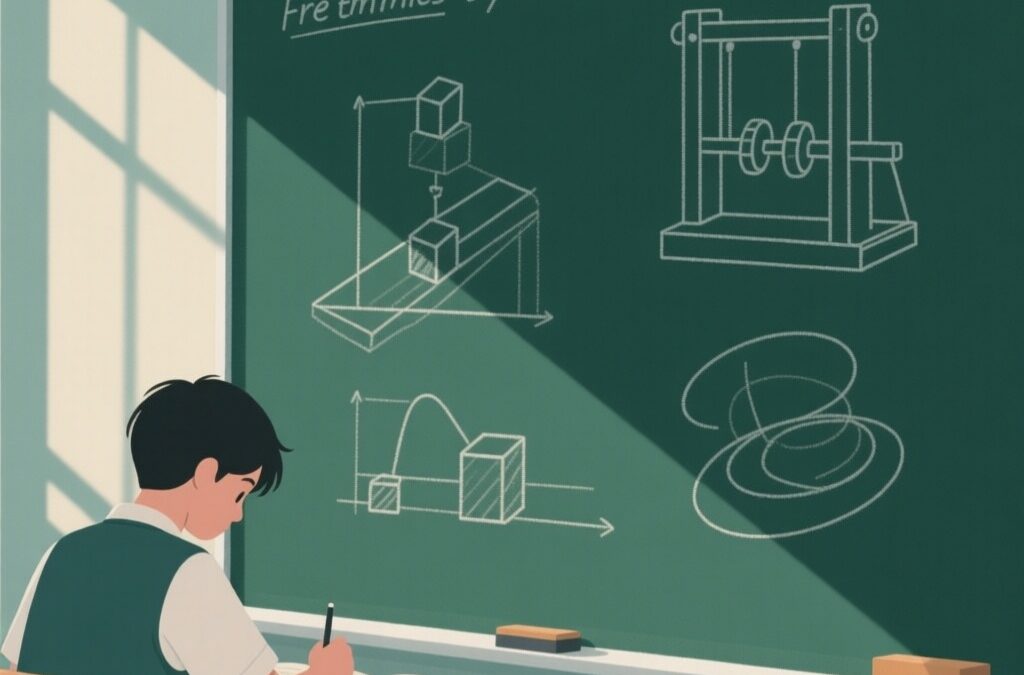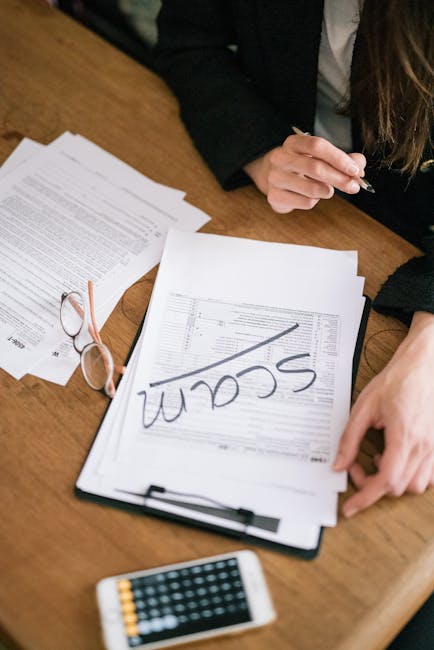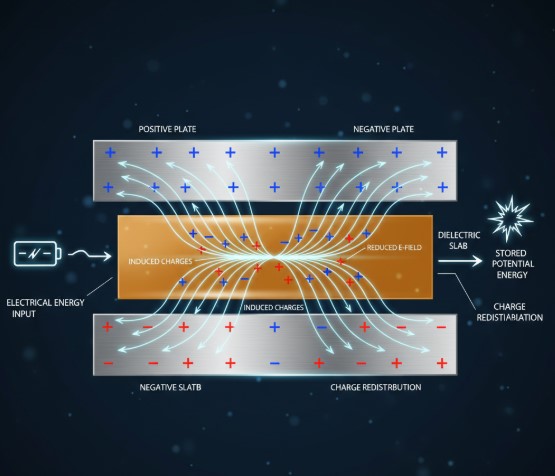The IIT JEE exam requires a deep understanding of physics, particularly in areas like spring and oscillation problems. These topics often appear in numerical form, demanding a strong grasp of formulas and problem-solving techniques. This blog post will guide you through essential concepts and provide step-by-step solutions. We will focus on mastering calculation-based problems related to IIT JEE spring problems.
Table of Contents
- Understanding IIT JEE Spring Problems
- Analyzing Spring and Oscillation Numericals for IIT JEE
- Problem 1: Two Blocks and a Spring — Corrected Solution with Full Explanation
- Givens and Assumptions
- Step 1: Spring Force via Hooke’s Law
- Step 2: Accelerations via Newton’s Second Law
- Step 3: Center-of-Mass (CM) Consistency Check
- Results Summary
- Why “toward each other,” not “away”?
- Common Pitfalls and Quick Fixes
- Similarly, we have below variations of problems
- Problem A (Compressed Spring): Directions Flip
- Problem B (Different Numbers, Stretched)
- Problem C (Single Block and Wall-Spring)
- Problem 2: Energy Conservation in Spring Systems — Maximum Speed of SHM
- Physical Picture and Key Assumptions
- Setup and Notation
- Method 1 (Energy Conservation): Derivation
- Method 2 (SHM Kinematics): Cross-Check
- Dimensional / Units Check
- Key Takeaways
- Quick Examples
- Common Pitfalls
- Additional Practice Problems (with Solutions)
- Problem A — Find Amplitude from Given Maximum Speed
- Problem B — Released from Rest at Displacement and with a Push
- Problem C — Time to Reach Maximum Speed (Optional Insight)
- Final Formula
- More IIT JEE Spring Problems to Practice
- Key Takeaways
Read More
Welcome, aspiring engineers! Today, we’re diving into the fascinating world of spring and oscillation problems, crucial for acing your IIT JEE exam. This post is designed to provide you with a comprehensive understanding of the concepts and problem-solving techniques necessary to tackle spring-related numericals. We’ll explore the fundamental principles, delve into detailed examples, and provide you with ample practice problems to solidify your grasp. Let’s begin our journey into the realm of elastic forces and oscillations!
Understanding IIT JEE Spring Problems
The IIT JEE exam often tests your understanding of spring and oscillation concepts. These problems typically involve calculating spring constants, potential energy, kinetic energy, and the motion of objects connected to springs. Mastering these concepts is essential for success in the exam. This section will focus on the basics: Hooke’s Law, spring potential energy, and the connection between force and displacement.
Hooke’s Law and Spring Force
Hooke’s Law is the cornerstone of understanding spring behavior. It states that the force exerted by a spring is directly proportional to its displacement from its equilibrium position. Mathematically, this is represented as ##F = -kx##, where ##F## is the spring force, ##k## is the spring constant (a measure of the spring’s stiffness), and ##x## is the displacement from the equilibrium position. The negative sign indicates that the force is a restoring force, always acting in the opposite direction of the displacement. This law is fundamental to solving most spring-related problems.
The spring constant, ##k##, is a critical parameter that defines the spring’s stiffness. A higher ##k## value indicates a stiffer spring, requiring more force to stretch or compress it. Understanding how to determine ##k## from given conditions or experimental data is a key skill. In many problems, you will be given ##k##, but in others, you might need to calculate it based on the force applied and the resulting displacement. Make sure you are comfortable with the units: Newtons per meter (N/m).
Spring Potential Energy
When a spring is stretched or compressed, it stores potential energy. This stored energy can be converted into kinetic energy when the spring is released. The potential energy (##U##) stored in a spring is given by ##U = (1/2)kx^2##, where ##k## is the spring constant and ##x## is the displacement from the equilibrium position. This equation is crucial for analyzing the energy transformations in oscillating systems.
Understanding the relationship between potential energy and kinetic energy is essential for solving problems involving oscillations. As the spring oscillates, energy continuously converts between potential and kinetic forms. At the equilibrium position (##x = 0##), the potential energy is zero, and the kinetic energy is at its maximum. At the maximum displacement, the potential energy is at its maximum, and the kinetic energy is zero. This interplay is key to understanding the behavior of oscillating systems.
Analyzing Spring and Oscillation Numericals for IIT JEE
Now, let’s tackle some example problems that frequently appear in IIT JEE. We will break down each problem step by step, explaining the concepts and calculations involved. We’ll cover various types of problems, including those with multiple blocks, different spring configurations, and energy considerations. Practice these examples to improve your problem-solving skills and boost your confidence for the exam. The focus here will be on calculation-based IIT JEE spring problems.
Problem 1: Two Blocks and a Spring — Corrected Solution with Full Explanation
Two blocks of masses ##m_1 = 2~\text{kg}## and ##m_2 = 3~\text{kg}## are connected by a light spring of constant ##k = 200~\text{N/m}## on a frictionless horizontal surface. The spring is initially stretched by ##x = 0.1~\text{m}## and the system is released from rest. We seek the instantaneous accelerations of each block right after release.
At the release instant, the spring exerts equal and opposite internal forces on the two blocks. Because the spring is stretched, its restoring force pulls the blocks toward each other (not away). We take “to the right” as positive; place the 2 kg block on the left and the 3 kg block on the right for sign clarity.
Givens and Assumptions
| Quantity | Symbol / Value | Notes |
|---|---|---|
| Mass of left block | ##m_1 = 2~\text{kg}## | Left block accelerates to the right (toward the center) |
| Mass of right block | ##m_2 = 3~\text{kg}## | Right block accelerates to the left (toward the center) |
| Spring constant | ##k = 200~\text{N/m}## | Ideal, massless spring |
| Initial extension | ##x = 0.1~\text{m}## | Measured from natural length |
| Surface | Frictionless | No external horizontal forces |
Step 1: Spring Force via Hooke’s Law
Hooke’s Law gives the magnitude of the restoring force:
### F_s \;=\; kx \;=\; 200 \times 0.1 \;=\; 20~\text{N}. ###
Directions at the instant of release:
- On the 2 kg block (left), the spring pulls rightward: ##F_1 = +20~\text{N}##.
- On the 3 kg block (right), the spring pulls leftward: ##F_2 = -20~\text{N}##.
Step 2: Accelerations via Newton’s Second Law
Apply ##F = ma## to each block at that instant:
### a_1 \;=\; \dfrac{F_1}{m_1} \;=\; \dfrac{20}{2} \;=\; 10~\text{m/s}^2 \quad (\text{to the right}), ### ### a_2 \;=\; \dfrac{F_2}{m_2} \;=\; \dfrac{-20}{3} \;=\; -6.67~\text{m/s}^2 \quad (\text{to the left}). ###
Thus, the blocks accelerate toward each other with magnitudes ##10~\text{m/s}^2## (2 kg block) and ##6.67~\text{m/s}^2## (3 kg block).
Step 3: Center-of-Mass (CM) Consistency Check
With no external horizontal force, the CM must have zero horizontal acceleration:
### a_{\text{CM}} \;=\; \dfrac{m_1 a_1 + m_2 a_2}{m_1 + m_2} \;=\; \dfrac{2(10) + 3(-6.67)}{5} \;\approx\; 0. ###
The small rounding arises from writing ##6.67## instead of the exact ##20/3##; using exact fractions yields identically zero CM acceleration, as required.
Results Summary
| Block | Force (N) | Acceleration (m/s##^2##) | Direction at Release |
|---|---|---|---|
| ##m_1 = 2~\text{kg}## | ##+20## | ##+10.00## | Toward the other block (right) |
| ##m_2 = 3~\text{kg}## | ##-20## | ##-6.67## | Toward the other block (left) |
Why “toward each other,” not “away”?
If the spring is stretched, its restoring force pulls its ends together. Therefore, each block is pulled toward the spring’s center, i.e., toward each other. (If the spring were compressed, the restoring forces would push the blocks away from each other.)
Common Pitfalls and Quick Fixes
- Wrong direction: Stretched → pull together; compressed → push apart.
- Forgetting signs: Use a clear axis; the forces on the two masses are equal in magnitude and opposite in direction.
- Mixing energy with instantaneous acceleration: Energy methods give speeds/positions over time; the immediate acceleration comes from ##F = ma## at that instant.
Similarly, we have below variations of problems
Problem A (Compressed Spring): Directions Flip
Two blocks of masses ##m_1 = 1~\text{kg}## and ##m_2 = 2~\text{kg}## are connected by a spring of constant ##k = 120~\text{N/m}##. The spring is compressed by ##x = 0.05~\text{m}## and released on a frictionless surface. Find the instantaneous accelerations and their directions.
Solution. Magnitude of the spring force at release:
### F_s \;=\; kx \;=\; 120 \times 0.05 \;=\; 6~\text{N}. ###
A compressed spring pushes its ends apart:
- On the left block: ##F_1 = -6~\text{N}## (to the left).
- On the right block: ##F_2 = +6~\text{N}## (to the right).
Accelerations:
### a_1 \;=\; \dfrac{-6}{1} \;=\; -6~\text{m/s}^2,\qquad a_2 \;=\; \dfrac{+6}{2} \;=\; +3~\text{m/s}^2. ###
CM check:
### m_1 a_1 + m_2 a_2 \;=\; (1)(-6) + (2)(3) \;=\; 0 \;\Rightarrow\; a_{\text{CM}}=0. ###
Problem B (Different Numbers, Stretched)
Two blocks of masses ##m_1 = 4~\text{kg}## and ##m_2 = 1~\text{kg}## are linked by a spring of constant ##k = 150~\text{N/m}## stretched by ##x = 0.04~\text{m}##. Find the instantaneous accelerations at release and comment on magnitudes.
Solution. Spring force magnitude:
### F_s \;=\; kx \;=\; 150 \times 0.04 \;=\; 6~\text{N}. ###
Stretched → pulls together:
- On the 4 kg block: toward the other block, say rightward ##(+6~\text{N})##.
- On the 1 kg block: toward the other block, leftward ##(-6~\text{N})##.
Accelerations:
### a_1 \;=\; \dfrac{+6}{4} \;=\; 1.5~\text{m/s}^2,\qquad a_2 \;=\; \dfrac{-6}{1} \;=\; -6~\text{m/s}^2. ###
The lighter block has a larger acceleration magnitude (inversely proportional to mass). CM check gives ##4(1.5) + 1(-6) = 0##.
Problem C (Single Block and Wall-Spring)
A single block of mass ##m = 4~\text{kg}## is attached to a spring of constant ##k = 200~\text{N/m}## fixed to a wall. The spring is stretched by ##x = 0.10~\text{m}## and released on a frictionless surface. What is the block’s instantaneous acceleration at release and in which direction?
Solution. Spring force magnitude: ##F_s = kx = 200 \times 0.10 = 20~\text{N}## toward the wall (restoring). Hence
### a \;=\; \dfrac{F_s}{m} \;=\; \dfrac{20}{4} \;=\; 5~\text{m/s}^2, ###
directed toward the wall (toward equilibrium).
Problem 2: Energy Conservation in Spring Systems — Maximum Speed of SHM
A block of mass ##m## attached to a light spring with spring constant ##k## is pulled to an initial extension (amplitude) ##x## from equilibrium and released on a horizontal frictionless surface. Using conservation of mechanical energy, determine the maximum velocity attained by the block during its oscillation.
Physical Picture and Key Assumptions
- Ideal spring (massless, obeys Hooke’s law), no damping, no external driving force.
- Horizontal, frictionless surface so that mechanical energy is conserved.
- Release from rest at maximum extension: initial speed is zero and initial spring potential energy is maximum.
Setup and Notation
| Quantity | Symbol | Meaning / Units |
|---|---|---|
| Mass | ##m## | In kilograms (kg) |
| Spring constant | ##k## | In newtons per meter (N/m) |
| Initial displacement (amplitude) | ##x## | In meters (m) |
| Angular frequency | ##\omega## | ##\omega = \sqrt{k/m}## (rad/s) |
Method 1 (Energy Conservation): Derivation
At release (maximum extension), all mechanical energy is stored as spring potential energy:
### U_{\max} \;=\; \tfrac{1}{2}\,k\,x^2. ###
When the block passes through equilibrium, the spring’s potential energy is zero and the energy is purely kinetic:
### K_{\max} \;=\; \tfrac{1}{2}\,m\,v_{\max}^2. ###
By conservation of energy (no losses):
### \tfrac{1}{2}\,k\,x^2 \;=\; \tfrac{1}{2}\,m\,v_{\max}^2 \;\;\Longrightarrow\;\; v_{\max} \;=\; x\,\sqrt{\tfrac{k}{m}}. ###
Result: The block’s maximum speed occurs at the equilibrium position and equals ##v_{\max} = x \sqrt{k/m}##.
Method 2 (SHM Kinematics): Cross-Check
Simple harmonic motion with amplitude ##A = x## has displacement ##y(t)=A\cos(\omega t + \phi)## and velocity ##v(t) = -A\omega \sin(\omega t + \phi)##. The amplitude of velocity is thus
### v_{\max} \;=\; A\,\omega \;=\; x\,\sqrt{\tfrac{k}{m}}, ###
which matches the energy approach.
Dimensional / Units Check
| Term | Unit Breakdown | Conclusion |
|---|---|---|
| ##\sqrt{k/m}## | ##\sqrt{(N/m)/kg} = \sqrt{(kg\;m/s^2)/m \cdot 1/kg} = \sqrt{1/s^2} = 1/s## | Has units of angular frequency |
| ##x\sqrt{k/m}## | ##m \cdot 1/s = m/s## | Correct velocity units |
Key Takeaways
- Maximum speed occurs at the equilibrium position where spring potential is zero.
- Maximum potential energy at the extremes converts entirely into kinetic energy at equilibrium.
- Formula (valid for ideal SHM): ### v_{\max} = x\,\sqrt{\tfrac{k}{m}}. ###
Quick Examples
- Example 1: ##m=0.50~~\text{kg}##, ##k=200~~\text{N/m}##, ##x=0.10~~\text{m}##.
### v_{\max} = 0.10 \sqrt{200/0.50} = 0.10 \sqrt{400} = 0.10 \times 20 = 2.0~~\text{m/s}. ### - Example 2: Doubling mass halves ##\omega## and thus halves ##v_{\max}## for the same amplitude.
- Example 3: If ##x=0##, then ### v_{\max}=0 ### (no motion).
Common Pitfalls
- Using instantaneous velocity where energy is mixed: Away from equilibrium, energy is shared between kinetic and potential; maximum speed is only at equilibrium.
- Confusing ##x## with instantaneous displacement: In the formula, ##x## is the amplitude (initial extension from equilibrium), not a generic position.
- Forgetting ideal assumptions: With friction or a massive spring, energy is not conserved in the simple form and the formula changes.
Additional Practice Problems (with Solutions)
Problem A — Find Amplitude from Given Maximum Speed
A ##0.80## kg block on a spring with ##k=72## N/m attains a maximum speed of ##1.8## m/s. Find the amplitude ##A## of oscillation.
Solution. From ### v_{\max} = A\sqrt{k/m} ###, we get
### A \;=\; \dfrac{v_{\max}}{\sqrt{k/m}} \;=\; \dfrac{1.8}{\sqrt{72/0.80}} \;=\; \dfrac{1.8}{\sqrt{90}} \;\approx\; \dfrac{1.8}{9.487} \;\approx\; 0.190~\text{m}. ###
Problem B — Released from Rest at Displacement and with a Push
A mass–spring system (##m=1.0## kg, ##k=100## N/m) is initially displaced by ##x_0=0.05## m and given an initial speed ##v_0=1.0## m/s toward equilibrium. Determine the amplitude and the maximum speed.
Solution. Total energy initially:
### E \;=\; \tfrac{1}{2}k x_0^2 \;+\; \tfrac{1}{2}m v_0^2 \;=\; \tfrac{1}{2}(100)(0.05)^2 \;+\; \tfrac{1}{2}(1)(1)^2 \;=\; 0.125 \;+\; 0.5 \;=\; 0.625~\text{J}. ###
Amplitude via ### E = \tfrac{1}{2}kA^2 \Rightarrow A=\sqrt{\tfrac{2E}{k}} = \sqrt{\tfrac{2(0.625)}{100}} = \sqrt{0.0125} \approx 0.1118~\text{m}. ###
Maximum speed: ### v_{\max} = A\sqrt{k/m} = 0.1118 \times \sqrt{100/1} \approx 1.118~\text{m/s}. ###
Problem C — Time to Reach Maximum Speed (Optional Insight)
For ideal SHM with ##\omega=\sqrt{k/m}## and release from rest at amplitude ##x##, the first passage through equilibrium (and hence first occurrence of ##v=v_{\max}##) takes one quarter of a period:
### T = \dfrac{2\pi}{\omega}, \qquad t_{\text{to eq}} = \dfrac{T}{4} = \dfrac{\pi}{2\omega} = \dfrac{\pi}{2}\sqrt{\dfrac{m}{k}}. ###
This timing result does not alter the maximum speed formula but is often useful in timing-related questions.
Final Formula
### \boxed{\, v_{\max} \;=\; x\,\sqrt{\dfrac{k}{m}} \,} ###maximum velocity is proportional to the displacement and the square root of the spring constant divided by the mass.
More IIT JEE Spring Problems to Practice
To further solidify your understanding of spring and oscillation problems, here are some similar problems with brief solutions. Practice these to improve your problem-solving speed and accuracy. Remember to apply the concepts of Hooke’s Law, potential energy, kinetic energy, and energy conservation. These practice problems will prepare you for more complex numericals in the IIT JEE spring problems section.
Problem 1
A spring has a spring constant of 500 N/m. If it is stretched by 0.2 m, what is the potential energy stored in the spring? Answer: 10 J
Problem 2
Two springs with spring constants ##k1 = 100 N/m## and ##k2 = 200 N/m## are connected in series. What is the effective spring constant? Answer: 66.67 N/m
Problem 3
A 0.5 kg mass oscillates on a spring with a period of 0.2 seconds. What is the spring constant? Answer: 49.35 N/m
Problem 4
A spring-mass system oscillates with an amplitude of 0.1 m. The mass is 1 kg and the spring constant is 400 N/m. What is the maximum velocity of the mass? Answer: 2 m/s
Problem 5
A block of mass 1 kg is attached to a spring and oscillates with a frequency of 2 Hz. What is the spring constant? Answer: 157.9 N/m
Key Takeaways
Mastering IIT JEE spring problems requires a solid grasp of Hooke’s Law, spring potential energy, and energy conservation principles. By practicing various types of numericals, you can build confidence and problem-solving skills. Remember to focus on step-by-step solutions, understand the underlying concepts, and practice regularly. With dedicated effort, you’ll be well-prepared to tackle spring and oscillation problems in the IIT JEE exam.
| Concept | Formula | Description |
|---|---|---|
| Hooke’s Law | ##F = -kx## | The force exerted by a spring is proportional to its displacement from equilibrium. |
| Spring Potential Energy | ##U = (1/2)kx^2## | The energy stored in a spring due to its displacement from equilibrium. |
| Effective Spring Constant (Series) | ##1/k_{eff} = 1/k_1 + 1/k_2## | The equivalent spring constant for springs connected in series. |
| Effective Spring Constant (Parallel) | ##k_{eff} = k_1 + k_2## | The equivalent spring constant for springs connected in parallel. |
We also Published
RESOURCES
- IIT JEE all Spring related Questions | Energy Cons/Cutting/NLM …
- Newton’s Laws of Motion | Pulley Problems IIT JEE | JEE Main
- JEE ADVANCED: EFFECTIVE SPRING METHOD – 3 WONDERFUL …
- Simple Harmonic Motion | Practice Problems | JEE Advanced
- How to solve Spring Mass System problems – YouTube
- Simple Harmonic Motion | Spring Mass System | IIT JEE
- Spring Mass Problems | Concepts | NLM | IIT-JEE Mains | Advance …
- First job using jee : r/java
- MIT students had a hard time-solving IIT JEE problems in a video I …
- eclipse – Maven2: Missing artifact but jars are in place – Stack Overflow







0 Comments